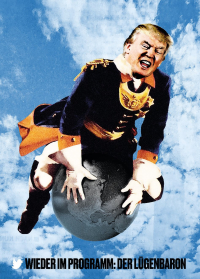| The reactor bankruptcy - THTR 300 | The THTR Circular |
| Studies on THTR and much more. | The THTR breakdown list |
| The HTR research | The THTR incident in the 'Spiegel' |
The THTR Circulars from 2012
***
| 2023 | 2022 | 2021 | 2020 | ||
| 2019 | 2018 | 2017 | 2016 | 2015 | 2014 |
| 2013 | 2012 | 2011 | 2010 | 2009 | 2008 |
| 2007 | 2006 | 2005 | 2004 | 2003 | 2002 |
***
THTR Circular No. 139, June 2012
Content:
After 26 years: black-out in the event of a THTR incident?
Pebble bed reactor in Jülich: On the trail of the operator's cover-up attempts!
Found heaps of bullets - what now?
Nuclear terrorism: no "crazy" villains, but power-hungry governments!
"Grassroots Revolution" turns 40 - and celebrates and discusses!
Successful campaign for the election campaign THeaTeR
After 26 years: black-out in the event of a THTR incident?
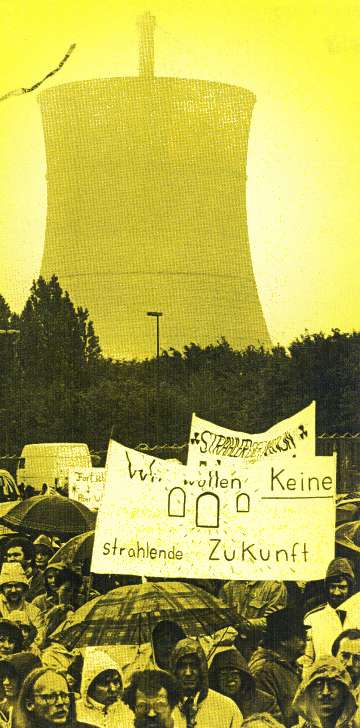 On April 26th, the GAU in Chernobyl was commemorated in various media. The incident in the thorium high-temperature reactor (THTR) in Hamm-Uentrop, which occurred just eight days later on May 4, 1986, was often forgotten in this context. Even in NRW.
On April 26th, the GAU in Chernobyl was commemorated in various media. The incident in the thorium high-temperature reactor (THTR) in Hamm-Uentrop, which occurred just eight days later on May 4, 1986, was often forgotten in this context. Even in NRW.
Even many people who witnessed that time or who participated in demonstrations in Hamm can no longer remember exactly what happened and the operators' cover-up maneuvers. In recent years this has meant that the Springer press, FAZ and other media have been able to fantasize about the unbelievable future prospects of an alleged disaster-free pebble bed reactor without provoking an outraged outcry. After Fukushima, the THTR was portrayed by them as a great hope for energy policy, although all the facts speak against it. At this point we help the "forgetful" a little on the jumps.
The "information disaster" lie
The friends of the pebble bed reactor make every effort to semantically translate the incident at that time into an "information incident". You are making use of the fact that the younger generation has not witnessed this incident itself.
Why did thousands of people bother to demonstrate against the THTR from 1986 to 1989 and block the driveways for days? - Were they all misinformed and misguided who had reacted completely over the top? What happened back then?
What information could you rely on back then? For example, on the information provided by the operator, who had previously glossed over dozens of incidents and breakdowns in the THTR? About the information from the responsible supervisory authority, the NRW state government, which has been one of the most ardent supporters of pebble bed technology for decades? Was objective information to be expected from them when it came to solid economic interests?
SPD flagship reactor
One of the preferred reactor types in the social democratic home state of North Rhine-Westphalia was the THTR research reactor in Jülich, whose accident from 1978 is only now being widely discussed in public. And especially the THTR in Hamm.
Mayors of the predominantly social democratically governed municipalities pooled the millions from the respective city coffers and founded the experimental reactor working group (AVR) for the THTR Jülich. Or they became shareholders in HKG for THTR Hamm and thus made common cause with the energy monopoly VEW. Because this promised them juicy returns and jobs.
All of these people saw their financial hides float away with the accident in 1986. The ruling social-democratic state government of North Rhine-Westphalia, that was ultimately also the operator side of the THTR and not a neutral approval and supervisory authority! In the days after the THTR incident, the citizens were left to fend for themselves.
Radioactive PAC beads
A central element of the THTR is the fuel element ball the size of a tennis ball, of which there were 675.000 in Hamm. As the name suggests, they are piled up in a large container to form a pebble. In addition to the graphite, a single fuel element ball contains thousands of tiny PAC balls that are just barely visible to the naked eye. PAC stands for Plutonium, Americium, Curium. If the highly radioactive fuel element ball is destroyed, the tiny balls and the graphite dust can spread and become a great danger.
52 bullets destroyed per full load day!
Due to the many incidents and breakdowns, the THTR was only in operation on 423 days at full load. During this time 17.000 fuel element balls were broken and another 5.000 broken balls were estimated for the discharge. The operator's side originally planned to break only 2 bullets per year. Statistically, however, 52 bullets were destroyed per full load day! These dimensions clearly show how big the problems in the THTR really were.
When state authorities reported 11 days after the reactor disaster in Chernobyl that 50.000 Becquerel per square meter had been measured at the THTR, the alarm bells rang for many people in Hamm. At that time the VEW published an extra sheet with the grotesque title "Chernobyl brought us 50.000 Becerel, the THTR only 0,1".
The statements of the VEW that this extraordinarily high value in Hamm had nothing to do with the THTR, was confirmed by the radiologist Dr. Dietrich Grönemeyer contradicted this. With his measuring devices he also measured very high levels of substances that could not have come from Chernobyl.
The pressure of the action group "farmers and consumers" and the public increased until finally after three more weeks the VEW subsequently publicly admitted the "event".
Measuring strips turned off at the crucial moment!
Radioactively enriched dust particles left the THTR via the exhaust chimney. Exactly at this point in time, the recording using measuring strips did not work for the operators. There were 5 gaps in total!
The NRW state government then commissioned an investigation report in which not a single nuclear power plant critic or member of the Ökoinstitut was involved. Of all people, those were commissioned with the investigation who had previously approved the breakdown operation of the THTR and nodded their uncritical nod.
In exactly the same resolution it was declared that HTR technology would continue to be considered a "preferred and safe reactor line" for the future. The result of the investigation was therefore anticipated. This behavior of the NRW state government was characterized by Professor Michael Karger as follows:
"A drug dead person has been found and his dealer has been asked for an investigation report."
On the same day that the investigation report was commissioned, the interrupted operation of the THTR was resumed. The Commission report came to the conclusion that it is not possible to clearly determine whether the approved daily limit value has been exceeded or not.
Despite all the efforts of the NRW politicians to save the THTR, things turned out differently. Additional incidents and more and more design defects made it necessary to retrofit. That got expensive. The participating and initially enthusiastic municipalities were also asked to pay. As a result, affection for the miracle reactor decreased significantly even in social democratic municipalities that were resistant to advice.
NRW Prime Minister: THTR is the last thing to switch off!
Not so with the NRW state government. Just a few months before the final shutdown in 1989, Prime Minister Johannes Rau committed to phasing out nuclear power. But he emphasized that the THTR is the safest of all nuclear power plants and that is why it must be switched off as the very last thing in Germany.
Even after the shutdown, efforts to bring the HTR line back to life continued. In 2001, SPD member Fritz Fahrenholt, as a "member of the Council for Sustainable Development at the Federal Chancellor" Schröder in "Vorwärts", propagated increased THTR research in order to have these reactors built again.
During the two red-green legislative periods from 1995 to 2005, further research was carried out for this line, especially in Jülich. The know-how was sold to South Africa, NRW companies such as Uhde-Dortmund and the Essener Röhrenwerke earned a lot from the atomic deal - and the construction in South Africa failed! 1,5 billion euros were wasted in South Africa.
THTR research
Because the light water reactors have fallen into disrepute due to the current incidents, there is now a risk that the HTR line will be pulled out of the moth box in a number of countries. Further research is carried out in Rossendorf near Dresden, at EU level as well as in the USA, India and Japan.
In China, preparations are being made to build a pebble bed reactor in response to the Fukushima disaster. And not by chance on the Shandong peninsula in Tsingtau (Qingdao), the former German colonial base. A pronounced transfer of science via pebble bed reactors takes place with the help of Rossendorf researchers to Poland.
Unfortunately, Federal Environment Minister Gabriel refused in 2008 to commission a child cancer study for the area surrounding the THTR.
Even 25 years after the incident, there is still no archive in which all the important documents on the THTR are scientifically processed and accessible to the public. If no remedial action is taken, there is a risk that critical knowledge of this incident will be lost in the coming decades. Then only what the operators and the state government of North Rhine-Westphalia have said about it will remain in historical memory: "Only one harmless, non-reportable event took place at the THTR in 1986". The critical view of the incident would be neglected.
So that this does not happen, we do the "www.reaktorpleite.de"
Pebble bed reactor in Jülich: On the trail of the operator's cover-up attempts! |
On May 15, 2012, Rainer Moormann and the journalist Jürgen Streich turned to Christian Küppers, the chairman of the investigation committee that deals with the history of accidents and the previously unprocessed radioactive water ingress at the AVR in 1978 in Jülich.
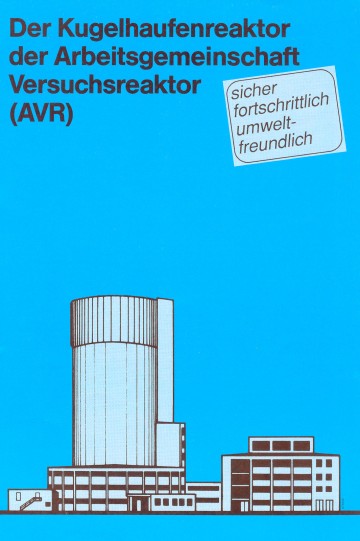 The Forschungszentrum Jülich (FZJ) has typically refused to give the two critics of the pebble bed reactor detailed information on this often ignored accident. However, the two have found a different source of information and are now giving initial indications of facts and questions that have not been sufficiently considered.
The Forschungszentrum Jülich (FZJ) has typically refused to give the two critics of the pebble bed reactor detailed information on this often ignored accident. However, the two have found a different source of information and are now giving initial indications of facts and questions that have not been sufficiently considered.
You write: "We have started looking through newly accessible documents on technical safety issues and incident processes and can already say that our worst suspicions have been exceeded - also with regard to dealing with criticality risks and even unauthorized manipulation of the reactor protection system in the course of the above 1978 event. "
Radioactive water in the soil since 1978
Moormann and Streich point out that 25-30 t of highly radioactive accident water in the soil and in the groundwater was only discovered after 21 years in 2000 and that additional measurements are necessary during future remediation work in order to arrive at realistic assessments of the health hazard potential.
According to the official version, most of the radioactive strontium has remained on site and has only left the reactor site to a lesser extent. However, in the opinion of Moormann and Strauch, it is urgent to check whether mobilizing influences such as changes in the pH value can be ruled out over decades.
Moormann and Streich consider the concentration of tritium to be very problematic: "There is still the possibility that larger amounts of tritium than HTO (= tritium compound, HB), while the water is being drained from the reactor and during the perhaps somewhat amateurish experiment, the radioactive water with a hastily brought in concrete mixer near the to consolidate the defective floor joint into the concrete chambers and thus into the groundwater. If this were the case, the AVR would have led to the largest known radioactive groundwater contamination in Western Europe: We have the currently valid drinking water limit value of 100 Bq / l for tritium with the total amount to compare with buried tritium of approx. 500 billion Becquerel.
So the question: Is it definitely certain that this tritium has taken the probably more harmless route into the atmosphere through evaporation, instead of going into the groundwater? Or was this argument perhaps in the foreground of not having to admit massive radioactive groundwater contamination and thus further reducing the market opportunities for pebble bed reactors? As you probably know, the expert at the time was hoping for the South Africa pebble bed reactor project PBMR and was relatively heavily involved there from around 2000 until its collapse in 2010. "
Has the groundwater been radioactively contaminated?
After the accident in the waterworks, no noticeable amounts of tritium were discovered on the lower floors. According to the official version, the groundwater contamination that has occurred is limited to the upper groundwater level, while the public drinking water was withdrawn from lower levels. However, this does not mean that an all-clear can be given:
"Regarding argument 3 it should be noted that
a) In addition to public drinking water abstraction, other forms of groundwater use occur (irrigation, cattle watering, etc.), which would preferably have affected the upper floor. Can such uses of the upper groundwater level be definitely ruled out for the period 1978-1982 in the downstream of the AVR?
b) According to information from Rheinbraun experts, there are connections between the groundwater levels in the relevant area. Can a seepage of radioactivity into deeper groundwater levels with drinking water abstraction be ruled out with sufficient certainty? Was the sequence of sampling in the waterworks for tritium measurement so close that a temporary "tritium cloud" should have been discovered in any case?
Finally, the question that arises for us is how exactly the tritium emissions were recorded via the exhaust air. As you may know, from 1966 to August 1973 it was not noticed that the tritium filters on the AVR were not working and that all tritium was released into the environment unfiltered.
Against the background that the frequent cases of childhood leukemia (1980-90) that occurred in the Jülich area can, at least in terms of time, be related to the AVR water ingress accident, we consider a thorough processing of these questions to be absolutely necessary. In particular, what we consider to be the premature dissuasion of FZJ, AVR and some official bodies in this matter should be questioned, because the population is entitled to complete documentation of the release processes and possible health consequences, including all uncertainties. "
Were high reactor temperatures permitted?
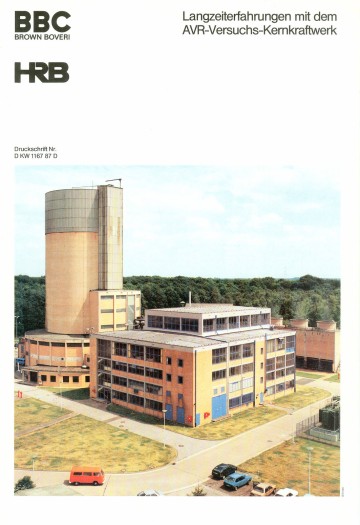 In conclusion, Moormann and Streich point out that in December 1987 it was experimentally established that the small THTR in Jülich had much higher temperatures than previously assumed at certain points. The question is asked whether the high temperatures during operation from 1974 to 1987 were outside of the 13th supplementary notice to the AVR approval. In other words, was the reactor even operated within the approved legal requirements?
In conclusion, Moormann and Streich point out that in December 1987 it was experimentally established that the small THTR in Jülich had much higher temperatures than previously assumed at certain points. The question is asked whether the high temperatures during operation from 1974 to 1987 were outside of the 13th supplementary notice to the AVR approval. In other words, was the reactor even operated within the approved legal requirements?
Unwanted results will not be published!
Incidents, high temperatures and water ingress at the AVR were calculated using the WAPRO computer program at the Jülich Research Center. However, only on the basis of estimated peak temperatures that are far too low.
"Calculations with higher peak temperatures are only known for reactor conditions from 1988 onwards, ie for less problematic cases with an overall lower temperature level of the reactor. To our knowledge, WAPRO results are also true for the problematic conditions 1974-87 (gas temperature 950 ° C plus real Graphite peak temperature of over 1300 ° C) was generated, but was never made public because of the undesired results (design accident not controlled, reactor therefore unsafe). We would therefore recommend that you request such WAPRO results from AVR. "
It is hair-raising how the FZJ has dealt with unpleasant test results and with the safety of people for decades. Here the tip of an iceberg becomes visible. What else will come of it?
By the way: In the monthly business newspaper "brand eins" from May 2012 there is a longer article about Rainer Moormann with the title "Can truth be sin?" appeared. You can read it here: http://www.brandeins.de/magazin/loyalitaet/kann-denn-wahrheit-suende-sein.html
Found heaps of bullets - what now? |
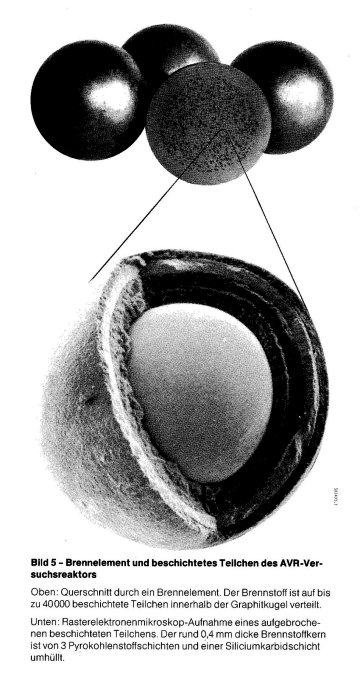 For the "Jugend forscht" competition, twelve-year-old Samantha Seithe and her scientific supervisor Achim Hucke did what the responsible state supervisory authorities had tried unsuccessfully for 21 years: They looked for the radioactive tiny spheres in the earth in the vicinity of the THTR , which were blown out of the exhaust chimney in 1986 eight days after the Chernobyl disaster in an accident in Hamm.
For the "Jugend forscht" competition, twelve-year-old Samantha Seithe and her scientific supervisor Achim Hucke did what the responsible state supervisory authorities had tried unsuccessfully for 21 years: They looked for the radioactive tiny spheres in the earth in the vicinity of the THTR , which were blown out of the exhaust chimney in 1986 eight days after the Chernobyl disaster in an accident in Hamm.
Seithe and Hucke found globules in large quantities in numerous places within a radius of up to three kilometers from the THTR. However, it is currently still unclear whether these are radioactive beads from the THTR.
Already in the last issue of the THTR-Rundbrief (1) we reported on the efforts to examine the approximately 0,4 mm small beads more closely. Some were handed over to the NRW State Institute for Work Design (LIA) in Düsseldorf. On April 17, the LIA gave the preliminary all-clear in the Westfälischer Anzeiger: The gamma radiation from the material was not radioactive. The examination of the alpha and beta radiation as well as the elemental analysis, with which it should be determined whether the beads can come out of the THTR, would take even longer, however.
At the council meeting of the city of Hamm on May 15, 2012, an application by the green parliamentary group was discussed to commission a cancer study for Hamm and the surrounding area and to thoroughly and comprehensively examine the globules found. The city administration referred to the investigation of the alpha, beta and gamma radiation of the spheres by the state office, which it is now familiar with. "No radioactivity was found," wrote the Westfälische Anzeiger (2). And further: "For the Greens, however, the issue has not yet been settled. You have heard of research by a researcher who does not want his name to be mentioned publicly, according to which the globules are indeed radioactive". He would have etched away the coating of the beads with acid and measured up to 40.000 Becquerel. "These results still have to be confirmed by more detailed investigations."
The WA reported further correctly: "Horst Blume, spokesman for the environmental protection initiative and avowed anti-nuclear activist, urges restraint. As long as all the facts are not on the table, he does not want to comment publicly on the case. He does not want to panic which in retrospect turns out to be unfounded ".
On May 21st, from 15 p.m. onwards, the LIA state institute posted the detailed results on its homepage (3) before. With the following result:
"Neither the measurement of gamma radiation, nor the measurement of beta radiation using liquid scintillation spectrometry, nor the alpha spectrometric investigation for the nuclide-specific determination of alpha emitters, an activity of artificial radioactive substances could be detected. (...)
To determine the alpha and beta activity, a microwave high-pressure digestion (total digestion) was carried out at 80 bar and 210 ° C., in which all components were brought into solution. The actinides (uranium, plutonium, thorium) were then separated radiochemically for alpha analysis. The measurement was carried out with the alpha spectrometry measuring system Alpha Ensemble (Ortec). A beta spectrometric analysis was carried out using the Quantulus 1220 liquid scintillation spectrometer (PerkinElmer). Neither nuclear fuel nor fission products could be detected in the sample. "
After the LIA has published its measurement methods and the results, hopefully another researcher will publish his results, which may differ from the LIA, in the next few weeks. When the Environment Committee of the City Council of Hamm deals with this matter on June 26th, hopefully both studies will be able to feed into the debate.
Achim Hucke has also initiated an online petition to the German Bundestag, demanding that the composition, origin and medical effects of the globules in Hamm, Geesthacht, Hanau and Jülich be carefully examined. It can be signed here until July 3rd, 7:
http://openpetition.de/petition/online/umwelt-und-gesundheit-bodenfunde-in-der-umgebung-von-kernkraftwerken
Notes:
1. See: THTR-RB No. 138
2. Westfälischer Anzeiger from May 17, 2012
3. See: http://www.lia.nrw.de/themen/strahlenschutz/umgebungsueberwachung/messung_hamm_uentrop/index.html
Nuclear terrorism: no "crazy" villains, but power-hungry governments! |
Between 2004 and 2009 I published a total of seven issues (1) of the THTR-Rundbrief reports in detail on the atomic smuggling network of the Pakistani Abdul Qadeer Khan. For more than 35 years this network has provided know-how and components for the construction of uranium centrifuges and thus also for the construction of nuclear weapons. This "nuclear supermarket" supplied numerous dictatorial regimes around the world and therefore poses a great danger.
Why did this intensive preoccupation with Khan take place in the THTR-Rundbrief, of all places?
As a young scientist, he worked at URENCO from 1972 to 1975 in the neighboring uranium enrichment plants in Almelo and Gronau, where he took blueprints and addresses of suppliers with him. Through the Uranit company, the Jülich nuclear research center was not only involved in the creation and development of high-temperature reactors, but also in the UAA Gronau.
And there is a second substantive reason: South Africa, which wanted to build a Pebble Bed Modular Reactor (PBMR) with Jülich help, has been a very important base of operations for the Khan network for decades. Even during the post-apartheid period. A country in which this criminal business could take place without major problems is not a particularly suitable place for the construction and operation of a nuclear power plant. As I said in the article "NuklearGangster!" (2) have shown, things went wrong here in terms of nuclear safety anyway: In 2007 there was even an armed attack on the control center of the nuclear research center; the now decommissioned atomic bombs from apartheid were stored right next door when the shooting took place.
Numerous newspapers have reported on the German and Swiss actors in the nuclear terror network over the past ten years. In May 2012, two longer articles were added, in which, in addition to what is known (and documented in the THTR circular), some news can also be read.
Forschungszentrum Karlruhe trained nuclear terrorists and acquired know-how
The "Context: Wochenzeitung" from Stuttgart, which is attached to the TAZ, dealt with its article "Die Pakistan-Connection" (The Pakistan Connection) on May 6, 2012 (3) with the intensive, highly official relationships between the Karlsruhe Research Center and the Pakistani atomic bomb makers. For information only: the Karlsruhe Research Center has also been involved in the development of the HTR line for decades. Has it attracted attention in its undertakings due to its particular sensitivity and caution?
"Context" reports the following about the highly explosive nuclear cooperation: "In fact, on June 25, 1974, an official" agreement on cooperation in the field of the peaceful uses of nuclear energy "was concluded between the Pakistan Atomic Energy Commission (PAEC) and the Karlsruhe nuclear research center Pakistan's archenemy India had carried out its first atomic bomb test a month earlier, and Pakistan's dictator General Zia ul-Haq had therefore ordered his country to build a bomb as well, even 'if we had to eat grass for it.' That agreement between the Karlsruhe and Islamabad spoke of a peaceful use of nuclear energy, but sensitive areas of uranium enrichment, reprocessing and heavy water production should also be explicitly covered. - These processes became apparent because this information from the National Security Archives (4) were made available to Washington University.
The German official bodies once again excelled themselves through gross lies in this delicate matter: "As recently as October 1979 the Foreign Office declared in a" briefing on the Pakistani nuclear program "literally: 'We have ensured that the German research institutes do not have any Pakistani scientists in the Train and employ the nuclear sector, especially in the sensitive area. ' Exactly the opposite was the case: the gentlemen from Islamabad had been working in Karlsruhe for a long time. (...) The verbal acrobatics continued for years. Only one day, an employee of the Federal Ministry of Economics and Business Administration broke his collar in an exchange of letters with the Foreign Office wrote an armed dispatch: "While, on the one hand, constant efforts are in progress to inhibit (prevent) the success of the Pakistani nuclear program, the Karlsruhe Nuclear Research Center is obviously in close contact with relevant Pakistani agencies in order to convey the knowledge for this very nuclear program."
The bad thing about the story: They are not old camels from the 70s, but this irresponsible policy continues to this day: "In 2006 the research center merged with the local university to form the Karlsruhe Institute of Technology. To this day, critical voices are trying a so-called civil clause, which to rule out research on material that could be used by the military. To this day, this attempt has failed. "
In the May issue of "Konkret", Detlev zum Winkel summarized the development of the Khan network in the three-page article "Condoleezza calling", as can be read in the seven issues of the THTR circular. In addition, however, it still comes up with some important new findings that should definitely be mentioned at this point. Much has been reported so far about the wide-spread network of relationships among the nuclear terrorist aid workers. Also about how, with the exposure of Libyan efforts to manufacture nuclear weapons, more and more incredible facts about this network came to light - and what role German and Swiss terrorist aid workers played (5).
"Villain" Khan was a tool of the intelligence services very early on
In his new discoveries, Zum Winkel relies mainly on English-language books by Douglas Franz and Catherine Collins. He recapitulates that the Khan's Swiss helpers, the Tinner family of engineers, were indicted in a sensational trial in Switzerland. Strangely enough, not only did the South African government refuse to help the court to clarify the matter, but the USA also exerted massive pressure on the Swiss authorities to have the incriminating files of Khan helper Tinner destroyed. Why? Because - so it was assumed - the Tinners had been working with the CIA since 2006 and no details of intelligence operations were to be made public.
Now "Konkret" quotes Frantz and Collins that the Tinner family would obviously have been recruited by the CIA between 2002 and 2004.
"A special task force broke into their house in 2003 in the absence of the Tinner family and copied and photographed all the documents found there, but did not take any originals with them Also building instructions for two more advanced nuclear weapons. The fact that the plans were left with the black marketeers means that they were allowed to pass them on. (...) Furthermore, Collins and Frantz report how the IAEA is examining the goods confiscated for Libya To their astonishment, inspectors discovered a sticker on a device from the place where it all began: the Los Alamos atomic bomb laboratory (USA) Pumps from the German company Pfeiffer Vacuum Technology had been delivered to the Khan network via New Mexico, which wasn't exactly The way they worked was imperceptible in the armory manipulated; there was a 'crazy' scientist who kept coming up with unusual ideas and implementing them with great zeal.
Manipulated Pfeiffer pumps from the same batch were also sold to Iran. Their use in Natanz is said to have led to the destruction of 50 centrifuges. So there were sabotage actions against the Iranian nuclear facilities years before Stuxnet, the cyberwar attack on their electronic control systems, and we are sure to hear only a fraction of them.
Was that what the US insisted on keeping secret because operations against Iran are still ongoing? That they observe, infiltrate, control and use the nuclear black market for their own purposes? "(6) Khan was supposed to be arrested twice by the Dutch authorities, in 1975 and 1985. But each time the CIA prevented this so that he could use him for his own purposes (7).
Detlev zum Winkel draws the obvious conclusion: "The 'dealer of death' was already a source before he closed his first deal. The CIA has held its protective hand through him and his network for three and a half decades. And in contrast to Khan's self-assessment Having done everything on his own he has been a tool of service. Should the international community deem it necessary to remove Pakistan from nuclear power, the Khan Research Laboratories would not have to be bombed, only some relevant states would have to bomb those of Pakistan comply with the Nuclear Non-Proliferation Treaty they have signed. "
What role did BND boss Wieck play?
Finally, another note: In 2012, Pakistani security authorities arrested three agents of the German Federal Intelligence Service (BND) in Peshawar and deported them (8). They were disguised as employees of the Society for International Development (GIZ). The Foreign Office tried to downplay the process. The Pakistan / India region is, of course, the area of operations for German federal services. And for a very long time. Georg Wieck, head (!) Of the BND from 1985 to 1990, quite by chance became the official German "ambassador" in India immediately after his term of office (9), the THTR-Rundbrief reported about it in great detail. Who is going to think of something very special?
And also quite by chance Wieck was an avid propagandist for the high-temperature reactor line. But he didn't have much success in this matter. The homepage "sbe-international", which he co-sponsored, has not been updated for over a year. In contrast to Wieck, who is now 84 years old, other secret service agents are still active as actors in the "nuclear supermarket" on behalf of various states.
Notes:
1. See THTR circular no. 95, 98, 99, 104, 111, 118, 125
2. See THTR Newsletter No. 118: "Nuclear Gangsters!"
3. See: http://www.kontextwochenzeitung.de/newsartikel/ 2012/05/die-pakistan-connection/
4. See: www.nsarchive.org
5. See "Gaddafi as a customer in Gronau" by Horst Blume in "Graswurzelrevolution" No. 358, April 2011:
http://www.graswurzel.net/358/gronau.shtml
6. Detlev zum Winkel in "Condeleezza calling", "Konkret" May 2012
7. See "Where Khadir Khan Learned To Love the Bomb" in
"THTR-Rundbrief" No. 104: http://www.reaktorpleite.de/nr.-104-januar-06.html
8. See: "South Asia," No. 1, 2012, p. 68
9. See: "Intelligence for the Thorium Industry" in
"THTR-Rundbrief" No. 134: http://www.reaktorpleite.de/thtr-rundbrief-nr-134-januar-2011.html
"Grassroots Revolution" turns 40 - and celebrates and discusses! |
No other national newspaper has been so closely linked to the history of our citizens' initiative for many decades as this monthly newspaper for a non-violent, domineering society. Since it was founded in 1972, the "Grassroots Revolution" has supported initiatives from below to fight with them against nuclear power and the military. Already in 1975 interested parties from Hamm and the non-violent action group from Dortmund (formerly Arnsberg) got to know each other through a classified ad in the GWR and together they founded the citizens' initiative against the THTR! The initial development of the BI and later the fight against the dangerous THTR line were accompanied by dozens of articles in the GWR for over 37 years.
The festival and conference for the 7th anniversary will take place in Münster (ESG, Breul 9) from September 43th to 40th. A lot of lectures, discussions and music contributions are offered. You can find more information here: www.grassroots.net
Successful campaign for the election campaign THeaTeR:Nuclear plants are just as safe and reliable as politicians! One rotten egg is enough ... |
Dear readers!
When Röttgen and Merkel spoke on May 3rd as part of the NRW election campaign on the market square in Hamm, we as a citizens' initiative with the largest banner were also present and confronted the CDU politicians with the specific question: "When do you switch them on Nuclear factory in Gronau finally off? " Three friends brought it with them from the Münsterland.
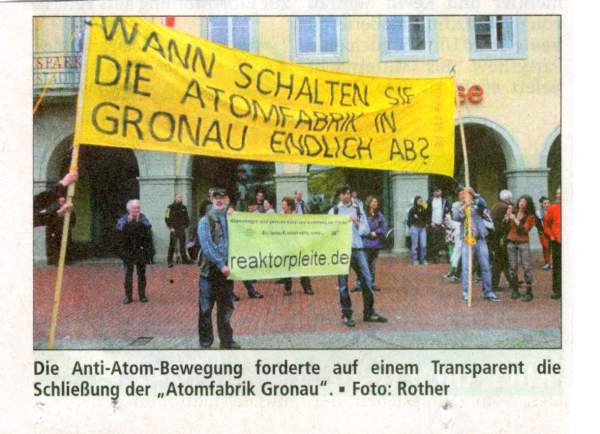
On another banner we pointed to our homepage "reaktorpleite.de" and said what we thought of the election theater: "Nuclear plants are just as safe and reliable as politicians! A rotten egg is enough, see ... THTR-Rundbrief". We were able to convey our concern to the almost two thousand spectators in an unmistakably clear manner. So the action was a success. For this short-term planned action we mobilized via the newsletter from the homepage "Hamm against Atom".
There are still some photos to be seen: http://www.hamm-gegen-atom.de/archiv/fotos/2012-05-mai/index.html
***
Top |
***
Donation appeal- The THTR-Rundbrief is published by 'BI Umwelt Hamm e. V. ' issued and financed by donations. - The THTR circular has meanwhile become a much-noticed information medium. However, there are ongoing costs due to the expansion of the website and the printing of additional information sheets. - The THTR circular researches and reports in detail. In order for us to be able to do that, we depend on donations. We are happy about every donation! Donations account:BI Umweltschutz Hamm |
***
Top |
***



